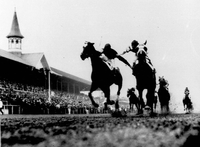November 17, 2004
Distance running 'shaped human evolution'
Our African ancestors may have been talented endurance athletes.
by Michael Hopkin
news@nature.com
Long-distance running was crucial in creating our current upright body form, according to a new theory. Researchers have suggested that our early ancestors were good endurance runners, and that their habit has left its evolutionary mark on our bodies, from our leg joints right up to our heads.
Early humans may have taken up running around 2 million years ago, after our ancestors began standing upright on the African savannah, suggest Dennis Bramble of the University of Utah, Salt Lake City, and Daniel Lieberman of Harvard University in Cambridge, Massachusetts. As a result, evolution would have favoured certain body characteristics, such as wide, sturdy knee-joints.
|
“Everyone says humans are bad runners. There's no question we're appalling sprinters, but we're quite good at endurance running.”
Daniel Lieberman Harvard University |
Our poor sprinting prowess has given rise to the idea that our bodies are adapted for walking, not running, says Lieberman. Even the fastest sprinters reach speeds of only about 10 metres per second, compared with the 30 metres per second of a cheetah. But over longer distances our performance is much more respectable: horses galloping long distances average about 6 metres per second, which is slower than a top-class human runner.
"Everyone says humans are bad runners, because when you think of running you tend to think of sprinting," he adds. "There's no question we're appalling sprinters, but we're quite good at endurance running."
Race training
How did we get so good at running? Scavenging is the best answer, Lieberman suggests. Our savannah ancestors would have been in competition with hyenas, who are also good long-distance runners, to get to the site of a big kill and pick over the remains. "You could see a flock of vultures on the horizon and just take off towards them," he says. Or perhaps early humans used their endurance simply to chase prey to exhaustion.
The theory makes sense of a raft of human characteristics, Bramble and Lieberman write in this week's Nature. Not only do we have springy Achilles tendons and stout leg-joints, our hairlessness and tendency to sweat make us very good at dissipating heat.
Running may even have improved our balance, says Fred Spoor, who studies human evolution at University College London. "Running requires a lot of delicate coordination: your legs are off the ground and you need to coordinate your eyes to see where your foot will land," he says.
Many animals keep their balance with the aid of semicircular canals in the inner ear, which are filled with fluid that acts as an acceleration detector. These structures are unusually large in both modern humans and our evolutionary cousin Homo erectus and this shows, says Spoor, that they might have helped primitive runners stay on their feet.
In fact, running seems to be the only reason that we have prominent buttocks, says Lieberman. He has measured the activity of the gluteus maximus muscle in volunteers during a walk and a jog. "When they walk their glutes barely fire up," he says. "But when they run it goes like billy-o."
It remains to be seen how the theory will be received, says Spoor. If correct, it means that the genus Homo is unique among primates in its running ability. But some experts maintain that there is nothing special about human locomotion, and what separates us from other apes is simply our outsized brains.
1 Bramble D. M., Lieberman D. E., Nature, 432. 345 - 352 (2004).
Article Copyright ⓒ 2004 MacMillan Publishers Ltd. All rights reserved. This material may not be published, broadcast, rewritten, or redistributed.
Trackback URL : 이 글에는 트랙백을 보낼 수 없습니다
Trackback RSS : http://www.fallight.com/rss/trackback/856
Trackback ATOM : http://www.fallight.com/atom/trackback/856
 2004e.pdf
2004e.pdf






